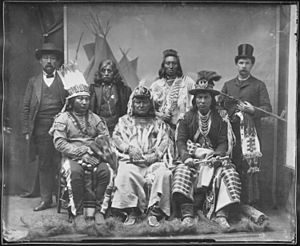Walla Walla people facts for kids

Sahaptin tribal representatives to Washington D.C. (1890)
|
|
| Total population | |
|---|---|
| 383 (2010) | |
| Regions with significant populations | |
| Languages | |
| English, Sahaptin dialect (endangered) | |
| Religion | |
| Traditional Religion (Washat), Christianity (incl. syncretistic forms) | |
| Related ethnic groups | |
| Sahaptin-speaking Umatilla, Cayuse, Yakama |
The Walla Walla people are an Indigenous group from the Pacific Northwest. Their name, Walawalałáma, means "People of the Walula region along the Walla Walla River." The name "Walla Walla" is often translated as "many waters."
Today, many Walla Walla people live on the Confederated Tribes of the Umatilla Indian Reservation. They share land and a government with the Cayuse and Umatilla tribes. This reservation is located near Pendleton, Oregon, close to the Blue Mountains. Some Walla Walla people are also part of the federally recognized Confederated Tribes and Bands of the Yakama Nation.
Contents
History of the Walla Walla People
The Walla Walla are a Sahaptin-speaking tribe. For hundreds of years, they lived in the Columbia River region of what is now northern Oregon and southeastern Washington state. They lived along the Walla Walla River and where the Snake River meets the Columbia River.
The Walla Walla people followed a seasonal way of life. They moved to different areas depending on the season to find food. This was similar to how the Yakama, Palouse, Umatilla, and Wanapum tribes lived.
First Meetings with Europeans
The Walla Walla people first met Euro-Americans during the Lewis and Clark Expedition in 1805. The American explorers promised to visit Walla Walla chief Yellepit again.
In April 1806, Lewis and Clark returned to Yellepit's village. It was located on the Columbia River, near the mouth of the Walla Walla River. During their visit, Chief Yellepit gave Clark a white horse. Since the Americans didn't have a copper kettle to trade, Clark gave Yellepit his own sword. He also gave him gunpowder and musket balls. Lewis and Clark also gave Yellepit a special peace medal with President Thomas Jefferson's picture and a small United States flag. A place called Yellepit, Washington was later named after him.
David Thompson, a Canadian-British explorer, arrived in Walla Walla lands in 1811. He was part of the North West Company (NWC). Thompson placed a pole near Yellepit's village. A letter on the pole claimed the land for the British Crown. It also said the NWC planned to build a trading post there. Thompson also met Chief Yellepit, who was friendly and encouraged the idea of a trading post. The trading post, called Fort Nez Percés, was built in 1818 at the mouth of the Walla Walla River.
Changes and Challenges
The Walla Walla people began to raise cattle. In 1844, about 40 Walla Walla, Nez Perce, and Cayuse people traveled to California. They went with Walla Walla chief Piupiumaksmaks to get more livestock. During this trip, Piupiumaksmaks' son, Toayahnu, was killed in a dispute.
In 1846, Chief Piupiumaksmaks returned with a small group, seeking peace. However, some members of his group were sick with measles. This disease, along with smallpox and other illnesses, spread quickly across the Columbia Plateau. These diseases greatly reduced the number of Indigenous people, including the Walla Walla. Despite these challenges, the Walla Walla people had many horses, which were very important to their wealth.
In 1855, the Walla Walla were one of the tribes at the Walla Walla Council. They signed the Treaty of Walla Walla along with the Cayuse, Nez Perce, Umatilla, and Yakama tribes.
Notable Walla Walla People
- Piupiumaksmaks (died 1855) – He was a very important chief of the Walla Walla people.
- James Lavadour (born 1951) – A famous painter and printmaker.
- Dan Henderson (born 1970) – An Olympic wrestler and mixed martial artist.
- Charles Sams (born around 1970) – The current director of the U.S. National Park Service.
See also
 In Spanish: Walla walla para niños
In Spanish: Walla walla para niños

